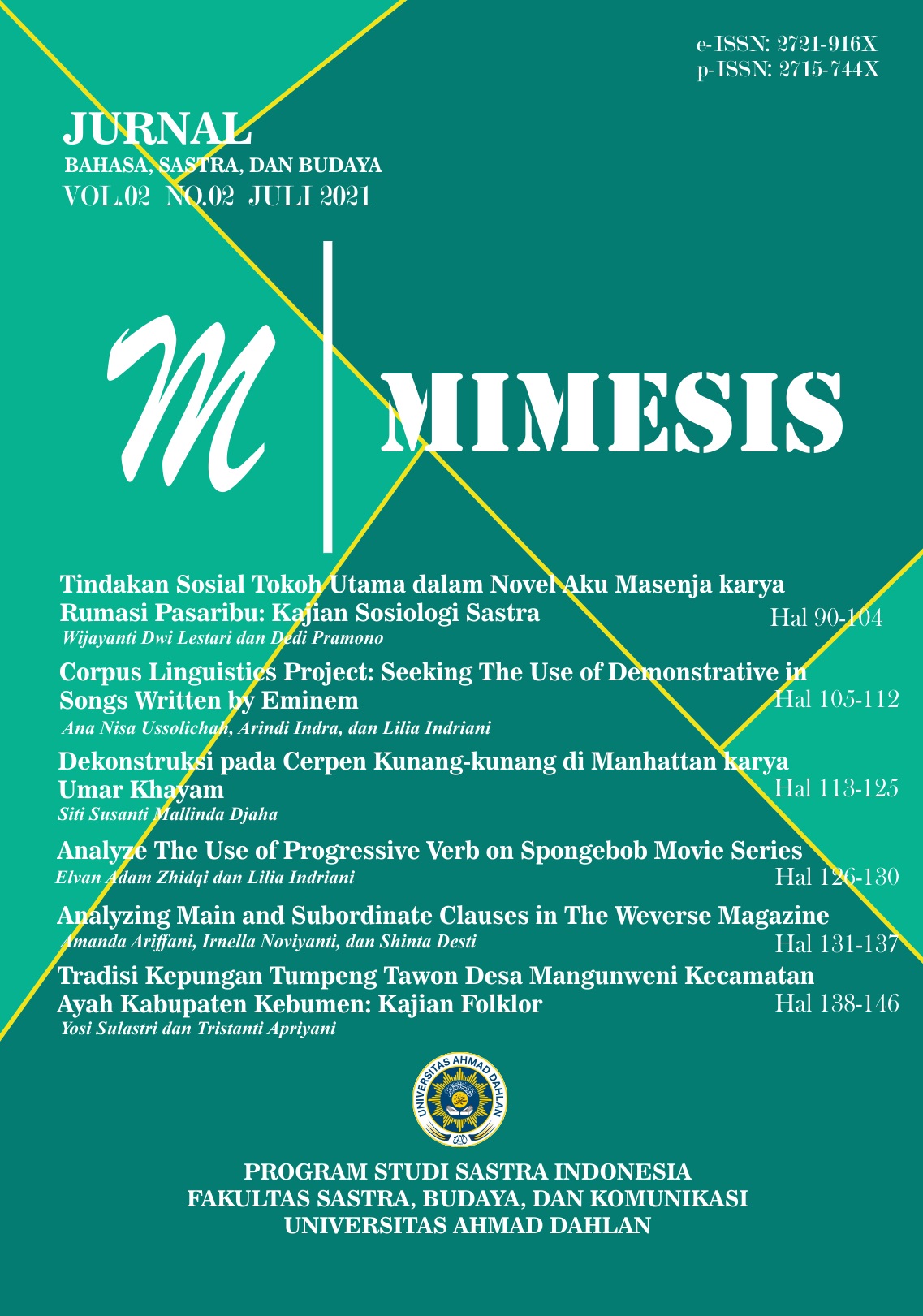TINDAKAN SOSIAL TOKOH UTAMA DALAM NOVEL AKU MASENJA KARYA RUMASI PASARIBU: KAJIAN SOSIOLOGI SASTRA
DOI:
https://doi.org/10.12928/mms.v2i2.4037Keywords:
Social behaviour, Novel Aku Masenja, Max Weber TheoryAbstract
This research is motivated by the importance of one actions in dealing with problem in everyday life, including the social life of the main character in the novel. This research aims to determine the forms of social behavior of the main character in the novel Aku Masenja by Rumasi Pasaribu. Social behavior theory refers to the theory social behavior from a male expert from Germany named Maximilian Weber or often called Max Weber.
The research subject used is the novel Aku Masenjaby Rumasi Pasaribu. The object this research is the social behavior of the main character based on Max Weber theory. This research is a qualitative descriptive study. The data analysis technique uses the reading technique and the note taking technique. Then the results of the data analysis are presented in descriptive form.
The results of this study indicate that the dominant form of social behavior that often appears in Aku Masenja is affective social behavior in the form of falling in love, anger, sadness, and suprise. While other actions such as behavior of instrumental rationality in the form of making decision, the desire to make parents happy, and the desire to protect students who are affected by the problem of values rationality behavior in the form moral values and religious values, tradisional behavior in the form of Pasemah community groups, the customs of a tribe in Bengkulu, the use of regional languages only a few forms appear.
References
Alis, M., & Norkholis. (2016). Analisis tindakan sosial Max Weber dalam tradisi pembacaan kitab Muktashar Al-Bukhari. Jurnal Living Hadis Vol 1 Nomor 2. Diambil dari http://ejournal.uin-suka.ac.id/ushuluddin/Living/article/view/1121
Anwar, Y & Adang. (2013). Sosiologi untuk universitas. Bandung: Refika Aditama.
Cintya, N.I. (2019). Konflik psikologi dalam novel Aku Masenja karya Rumasi P. dan relevansinya dengan pembelajaran sastra di perguruan tinggi. Prosiding Seminar Nasional. Diambil dari http://pgsd.umk.ac.id/files/prosiding/2019/6__Cintya_Nurika_Irma.pdf
Damono, S.D. (1979). Sosiologi sebuah pengantar. Jakarta: Pusat Pembinaan dan Pengembangan Bahasa Departemen Pendidikan dan Kebudayaan.
Desri, A.E. (2019). Tafakkur dalam perspektif Al-Quran. Jurnal El-Qanuny. Diambil dari http://jurnal.iaim-padangsidimpuan.ac.id/index.php/elqanuniy/article/view/2154/172
Endraswara, S. (2003). Metodologi penelitian sastra epistemologi, model, teori, dan aplikasi. Yogyakarta: Pustaka Widyatama.
___________. (2011). Metodologi penelitian sastra. Yogyakarta: CAPS.
___________. (2016). Metode penelitian ekologi sastra konsep, langkah, dan penerapan. Yogyakarta: CAPS.
Lilik, N. (2016). Analisis tindakan sosial para tokoh dalam naskah drama Godlob karya Danarto dengan pendekatan sosiologi sastra Max Weber. Skripsi. Diambil dari http://eprints.unram.ac.id/9791/
Nurgiyantoro, B. (2013). Teori pengkajian fiksi.Yogyakarta: Gadjah Mada University Press.
Pasaribu, R. (2017). Aku masenja.Yogyakarta: Araska.
Rafiek, M. (2013). Pengkajian Sastra: Kajian Praktis. Bandung: Refika Aditama.
Ritzer, G., & Goodman, D. J. (2008). Teori sosiologi (edisi terbaru). Yogyakarta: Kreasi Wacana.
Siswantoro. (2005). Metode penelitian sastra: analisis psikologis. Yogyakarta: Pustaka Pelajar.
__________. (2016). Metode penelitian sastra analisis struktur puisi. Yogyakarta: Pustaka Pelajar.
Sugihastuti. (2007). Teori apresiasi sastra.Yogyakarta: Pustaka Pelajar.
Sugihastuti & Suharto. (2002). Kritik sastra feminis, teori, dan aplikasinya. Bandung: Nuansa.
Susan. N.T., Zulfahita., & Revi, J. (2019). Tindakan sosial tokoh utama dalam novel kerumunan terakhir karya Okky Madasari. Jurnal Cakrawala Linguista. Diambil dari https://journal.stkipsingkawang.ac.id/index.php/Cling/article/view/876/pdf
Susanto, H., & Santoso, B.W.J. (2017). Wujud peralihan kode dalam peristiwa tutur informal masyarakat multietnis di stkip singkawang kalimantan barat. Jurnal Pendidikan Bahasa dan Sastra Indonesia Volume 2, Nomor 1, Page 26-30. Diambil dari https://journal.stkipsingkawang.ac.id/index.php/JP-BSI/article/view/235/192
Teguh, A.N., Herman, J.W., & Suyitno. (2017). Kajian sosiologi sastra dan pendidikan karakter dalam novel simple miracles karya ayu utami serta relevansinya pada pembelajaran sastra di sma. Jurnal Ilmiah Didaktika Vol 18, No.1. Diambil dari http://jurnal.ar-raniry.ac.id/index.php/didaktika/article/view/3090/2203
Teuuw, A. (1967). Sastra Indonesia modern II. Jakarta: Pustaka Jaya.
Titje, P. L. (2019). Keberadaan bahasa rejang pesisir kabupaten bengkulu utara ditinjau dari segi kesantunan bahasanya. Jurnal Lateralisasi Volume 7 Nomor 2. Diambil dari http://jurnal.umb.ac.id/index.php/lateralisasi/article/view/551/416
Downloads
Published
Issue
Section
License
Copyright (c) 2021 Wijayanti Dwi Lestari

This work is licensed under a Creative Commons Attribution-ShareAlike 4.0 International License.
License and Copyright Agreement
In submitting the manuscript to the journal, the authors certify that:
- They are authorized by their co-authors to enter into these arrangements.
- The work described has not been formally published before, except in the form of an abstract or as part of a published lecture, review, thesis, or overlay journal.
- That it is not under consideration for publication elsewhere,
- That its publication has been approved by all the author(s) and by the responsible authorities tacitly or explicitly of the institutes where the work has been carried out.
- They secure the right to reproduce any material that has already been published or copyrighted elsewhere.
- They agree to the following license and copyright agreement.
Copyright
Authors who publish with Mimesis agree to the following terms:
- Authors retain copyright and grant the journal right of first publication with the work simultaneously licensed under a Creative Commons Attribution License (CC BY-SA 4.0) that allows others to share the work with an acknowledgment of the work's authorship and initial publication in this journal.
- Authors are able to enter into separate, additional contractual arrangements for the non-exclusive distribution of the journal's published version of the work (e.g., post it to an institutional repository or publish it in a book), with an acknowledgment of its initial publication in this journal.
- Authors are permitted and encouraged to post their work online (e.g., in institutional repositories or on their website) prior to and during the submission process, as it can lead to productive exchanges, as well as earlier and greater citation of published work.











